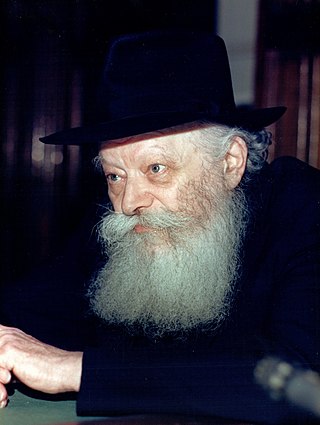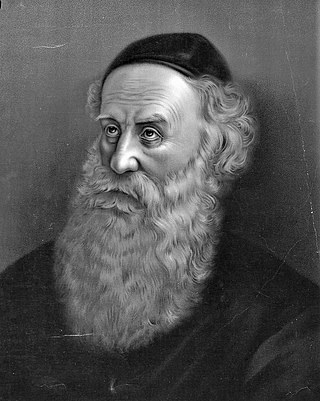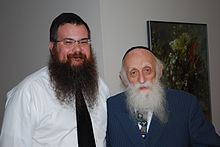
Menachem Mendel Schneerson, known to many as the Lubavitcher Rebbe or simply the Rebbe, was an Orthodox rabbi and the most recent Rebbe of the Lubavitch Hasidic dynasty. He is considered one of the most influential Jewish leaders of the 20th century.

Chabad, also known as Lubavitch, Habad and Chabad-Lubavitch, is an Orthodox Jewish Hasidic dynasty. Chabad is one of the world's best-known Hasidic movements, particularly for its outreach activities. It is one of the largest Hasidic groups and Jewish religious organizations in the world. Unlike most Haredi groups, which are self-segregating, Chabad operates mainly in the wider world and caters to secularized Jews.

A Rebbe or Admor is the spiritual leader in the Hasidic movement, and the personalities of its dynasties. The titles of Rebbe and Admor, which used to be a general honor title even before the beginning of the movement, became, over time, almost exclusively identified with its Tzaddikim.

Shneur Zalman of Liadi was a rabbi and the founder and first Rebbe of Chabad, a branch of Hasidic Judaism, then based in Liadi in the Grand Duchy of Lithuania and later in the Grodno Governorate of the Russian Empire. He wrote many works, and is best known for Shulchan Aruch HaRav, Tanya, and his Siddur Torah Or compiled according to the Nusach Ari.

The Tanya is an early work of Hasidic philosophy, by Rabbi Shneur Zalman of Liadi, the founder of Chabad Hasidism, first published in 1796. Its formal title is Likkutei Amarim, but is more commonly known by its first Hebrew word tanya, which means "it has been taught", where he refers to a baraita section in "Niddah", at the end of chapter 3, 30b. Tanya is composed of five sections that define Hasidic mystical psychology and theology as a handbook for daily spiritual life in Jewish observance.

Sholom Dovber Schneersohn was the fifth Rebbe of the Chabad Lubavitch chasidic movement. He is known as "the Rebbe Rashab". His teachings represent the emergence of an emphasis on outreach that later Chabad Rebbes developed into a major theme.

Kehot Publication Society is the publishing division of the Chabad-Lubavitch movement.

Abraham Joshua Heshel Twerski ; October 6, 1930 – January 31, 2021) was an Israeli-American Hasidic rabbi, a scion of the Chernobyl Hasidic dynasty, and a psychiatrist specializing in substance abuse.

Strashelye was a branch of the Chabad school of Hasidic Judaism, named after the town Strashelye (Starasel'lye) in the Mohilev Province of present-day Belarus, where its leader lived. Like all Hasidism it is based on the teachings and customs of Chasidut as taught by the Baal Shem Tov, in turn based on the Kabbalistic works of Rabbi Isaac Luria.
Mashpia or feminine Mashpi'oh lit. "person of influence", pl. Mashpi'im is the title of a Hasidic rabbi who serves as a spiritual mentor, whose main influence and teachings are in matters of the worship of God, the correction of virtues and spiritual elevation.

Like many other Hassidic movements, Chabad-Lubavitch has its own unique niggunim, or traditional melodies. Chabad niggunim were either composed or taught by the Rebbe of Chabad or their Hassidim. Niggunim are used to aid for meditation during Chasidic prayer or Torah study, as well as during farbrengens. some of these ancient Chabad melodies have recently made their way into mainstream music.

Chabad philosophy comprises the teachings of the leaders of Chabad-Lubavitch, a Hasidic movement. Chabad Hasidic philosophy focuses on religious concepts such as God, the soul, and the meaning of the Jewish commandments.

Rami M. Shapiro, commonly called "Rabbi Rami", is an author, teacher, and speaker on the subjects of liberal Judaism and contemporary spirituality.

Chabad customs and holidays are the practices, rituals and holidays performed and celebrated by adherents of the Chabad-Lubavitch Hasidic movement. The customs, or minhagim and prayer services are based on Lurianic kabbalah. The holidays are celebrations of events in Chabad history. General Chabad customs, called minhagim, distinguish the movement from other Hasidic groups.
Nissan Mindel was a Chabad Hasidic rabbi, author, editor, and served on the administrative staff of Rabbi Menachem Mendel Schneerson, the seventh Lubavitcher Rebbe.

Rabbi Zalman I. Posner was an American rabbi and writer associated with the Chabad-Lubavitch Hasidic movement. Posner served as a congregational rabbi and community leader in the American Southeast for five decades, serving the Orthodox congregation Sherith Israel and founding an Orthodox Day School both in Nashville, Tennessee.

Happiness in Judaism and Jewish thought is considered an important value, especially in the context of the service of God. A number of Jewish teachings stress the importance of joy, and demonstrate methods of attaining happiness.

Yehoshua Mondshine (1947–2014) was an Israeli rabbi, scholar, researcher and historian associated with the Chabad-Lubavitch, Hasidic movement. Mondshine worked as a librarian and bibliographer at the National Library of Israel in Jerusalem.
Yosef Yitzchak "Yossi" Jacobson, also known as YY Jacobson, is an American Chabad rabbi and speaker from Monsey, New York.

Hasidic Judaism in Lithuania is the history of Hasidic Judaism and Hasidic philosophy in Lithuania and parts of modern-day Belarus. Hasidic Judaism in Lithuania began with R. Aaron Perlow of Karlin (Karalin) (1736–1772), R. Menachem Mendel of Vitebsk (1730?–1788) R. Shneur Zalman of Liadi (Lyady) (1745–1812) and to a lesser extent R. Hayim Haykl of Amdur (Indura), all of whom were disciples of R. Dov Ber of Mezeritch (Mezhirichi), who in part was the successor to the R. Israel Baal Shem Tov who founded Hasidic Judaism in Western Ukraine. In its earliest years, Lithuanian Hasidism suffered immense persecution by the Lithuanian Misnagdic rabbinate, who attempted to ban and excommunicate Hasidism on several occasions in Lithuania beginning with R. Elijah b. Solomon Zalman of Vilna (1720–1797), who was the earliest disseminator of anti-Hasidic thought which flourished in Lithuania.















